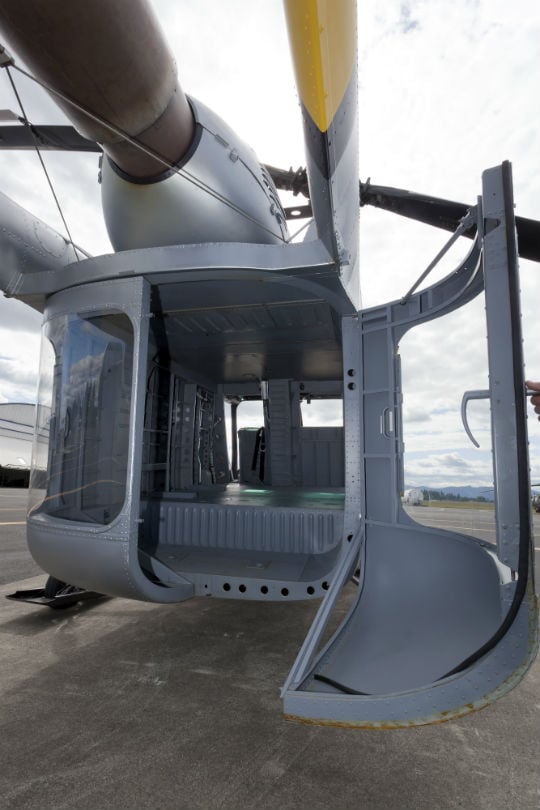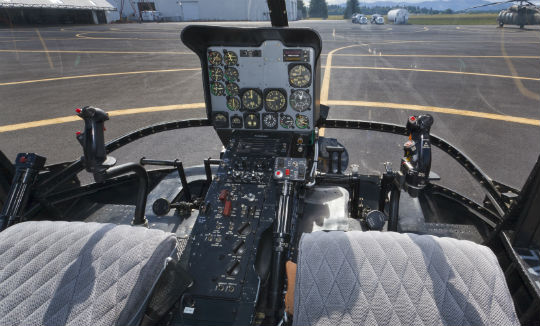
Designed primarily for close-in firefighting and rescue duties at military bases, the Huskie was occasionally used for short-range search-and-rescue missions during the Vietnam War. When responding to aircraft accidents, it was often equipped with a 950-pound (430-kilogram) fire suppression kit (FSK) — a suspended unit that held 78 gallons of water with a separate container that had five gallons of concentrated foam. When the water and concentrate combined, the FSK could generate 690 gallons of aeriated foam.
The extremely powerful downwash from the Huskie’s rotor system could be used to help suppress flames and spread the foam over the fire. The rotors could also be used to direct the fire away from ground personnel. Once the flames were held at bay, the airborne firefighters could move in to extricate the crew of the wrecked airplane. After ending their military careers, many Huskies found a living in the timber industry.

Reynolds had wanted an H-43 since he first saw one while on a logging contract, but the demand and the prices were too high at that time for him to get one. As the helicopter logging market died down, the H-43’s spare parts inventory had also been largely consumed, and so the price of the aircraft dropped. Terra Helicopters of McMinnville, Oregon, asked Reynolds he would be interested in trading one of his Bell UH-1Hs for a Huskie, and the deal was done. The Huskie made its way to Northwest, where Kevin Lederhos (who now works as the company’s director of development) restored it. He still applies his expertise on a regular basis to keep the H-43 in great shape.
Today, the aircraft spends most of its time in one of the Northwest’s hangars or in the museum. As its wooden rotor blades are a limited life item — and there are no spares on hand — it isn’t flown very often. This will ensure it is able to take to the skies for many more years, making the occasional airshow appearance within a few miles of its home field.

The Huskie is a helicopter that must be approached much the same way you would approach a rattlesnake: Do it very carefully and watch where you are walking. Unlike most helicopters, where the blades are in a fairly steady plane of rotation on the ground, the Huskie’s distinctive intermeshing blades rotate at an angle to the fuselage. As such, you always approach it from the front or back, as that is where the blade height is the highest. (At the sides of the helicopter the blades are just about seven feet above the ground as they rotate — and when you pull pitch, the blades flex and come even closer to the ground.)
People always ask what it is like to fly the Huskie. “Flying the H-43 is a challenge for sure — especially in the wind,” said Reynolds. “It’s like flying two helicopters in close formation. It’s rough, slow, shakes a lot, and doesn’t fly like any other helicopter. It’s probably one of the only helicopters that a regular helicopter pilot can’t just climb in and fly off — it has too many idiosyncrasies. It does not like tail winds at all. As a matter of fact, it’s a handful in any wind. It has to be flown with large control inputs, including pedal. The pilots I have seen get [closest] to figuring it out on the first flights were Chinook pilots. But, even they need a couple [of] flights to figure out how to make it turn. Flying the H-43 has to be planned out for sure.”

Chances to see a Huskie are few and far between. Being able to see one in flight is even more rare. Make a trip out to Olympia, Washington, around Father’s Day weekend (June 18 and 19) for the museum’s annual airshow and watch her fly. She might not go on the list of the prettiest Helicopter you’ve ever seen, but it will be hard to walk away without a smile on your face.










Loved the Husky. Flew her from 1969 to 1973 at Bien Hoa (70-71) and Columbus AFB MS 71-73.
My Father”Maj.Rapid Robert” flew the hh-43 in vietnam 65 to67 and 69to 71 and loved the ”pedro”! I asked him how many rescues did he make he said 28 successful.my father told me on a rescue mission you were a sitting duck but you had a motto to honor “‘THESE THINGS WE DO THAT OTHERS MAY LIVE!” He had over 3500 hrs in the huskie and cherished them all.Later on he was chosen to fly the hh-53 Super jolly –hated it called it a ”crowd killer” lot of close calls,but it was a new bird with a lot of bugs in her yet to be figured out!
My dad flew the Husky in the early 60’s he was stationed in Thailand and Spain. Wish there was one down in Texas that could see fly.
I had the distinct honor of flying as an airborne firefighter for 3 1/2 years on the hh-43. I started at Kincheole AFB in Michigan’s Upper Peninsula, than Incirlk Air Base in Turkey ending my term at Pleiku Air Base in Vietnam. All were great experiences, and the best job in the Air Force. All the crews were exceptional and gave the true meaning of the Air Rescue Moto “We do these things that others may live”
Medal of honor winner flew the husky it hold many records and one for most saves so it is one hell of a machine
I served on the Navy Hospital Ship Repose during the Vietnam conflict. We received patients a couple of times from Husky crews and I remember the large lettering along the sides: approach only from the front or rear. We always were careful working around the Husky, especially the tall sailors, because the rotor blades came down below the specified 7 ft along the sides. I have wondered if anyone was killed when trying to help with patients. I have read that this helicopter was very effective in fire suppression.
I worked at Kaman in SH-2 LAMPS MK1 helicopter program in the late 1970s until 1990. Nothing in the files led me to believe that anyone had died due to a Husky blade strike.. However, my time at the plant (Kaman) was after the H-43 left military service.
FYI, in the mid 1980s the USCG discovered that their Dolphin MH-65 helicopter’s main rotor blade tips could come within 5ft.. 3in. of a ship’s deck during high sea-state landings. That caused the USCG to install the Fairey Hydraulics Harpoon Deck Lock on their helicopters. (The need to send men out on a moving flight deck of a Coast Guard Cutter to chain down the helicopter was therefore no longer a problem.)
My cousin worked at Kaman Aircraft (later Kaman Aerospace) in the early 1960s while the HH-43B/F (“Pedro”) was still in production. As a pre-teen, I remember watching a ‘Husky’ at a Kaman Family Day. A decade later I served in the Navy as CICO (Radar Officer) on a Destroyer Escort/Frigate.. My Division included anti-submarine warfare air controllers for the Kaman SH-2F LAMPS MK1 helicopter we had onboard.
In the early 1980s, while working in the Military Marketing Department at Kaman Aerospace I received a call from an international marketing firm that wanted to purchase 18 Kaman HH-43F helicopters. Sadly, the higher-ups in the company said “no” to the prospect of reopening the production line.) Ten years later, I left Kaman. I understand that they managed to put together an operational HH-43 as part of the K-Max program. It was rumored that a small quantity of new rotor blades was discovered in Pakistan, still in their original unopened USAF containers. (Iran also may have had a quantity of HH-43 helicopters but I doubt that anyone could have managed to get their hands on them.)
As a side note, my boss confirmed that in 1961 the Husky was the first helicopter to fly with composite rotor blades.
I. Was stationed at Cam Ranch Bay. 66 _67 in “Pedro 48 and 51. Not a bird you could just jump in and fly but once you adjusted to her idiosyncrasies. It was a great Bird that did everything asked of it. Still have my flight gear from 38th A R R S.
One is waiting at Castle waiting restoration .
I was a mechanic/crewchief on the H43-B model at Phan Rang Airbase 1967-1968. Never heard a bad word from the pilots about how the chopper was to fly, with or without the FSK. Also mintained them at Sheppard AFB after Vietnam, pilots had no complaints.
I was a Rescuemen/Firefigther HH-43B Pedro Det.3 38th ARRS Ubon,Thailand for over 20 months 69-70 went up in the HH-43B 175 Times 5 Air Metals and she always got us back on the ground safe, best 20 months of my 32yrs in the fire service. Got to work with some of best people ever, men that were there to do the best job, and save lives.